Vermeer's Neighborhood
(part three)
(part three)
In the time of Vermeer, about a quarter of the population of Delft was Catholic. Some Catholics resided in the so-called "Papenhoek," or Papists' Corner adjacent to the Nieuwe Kerk. The Papist Corner was not a ghetto because many of the families who chose to live there did so by their own free will, and were prosperous. Although Catholics were not actively repressed, they were not altogether free to act as they wished.
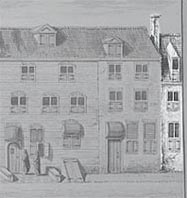
According to the research of John Michael Montias, by 1686, the Papist Corner included 15 houses in all. One was the Catholic "hidden" church, as it was called, and another a Jesuit school. The image to the right (f.) shows the Jesuit church in the early eighteenth century. From left to right would be the Jesuit school, a house, the church where two people can be seen standing, and seen partially on the edge of the drawing, the Thins' house, or possibly one just to the right of it, beyond the edge of the drawing.
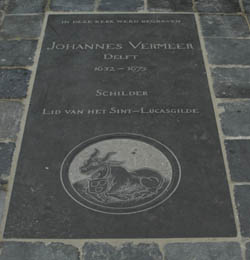
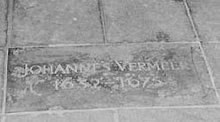
The Oude Kerk is Delft's oldest parish church. Founded about 1200, it was gradually replaced by a much larger church. The tower, erected between 1325 and 1350, was probably built on a filled-in canal. Throughout the ages, the leaning tower has been the cause of considerable alarm to many an inhabitant.
Vermeer, who was born in Delft, was interred in his mother-in-law's family crypt after his death in 1675 in the Oude Kerk, although the exact location of his grave site has bee lost. Vermeer's generous mother-in-law, Maria Thins, bought a grave in the church in 1661. Even though the church was for Protestant worship, Catholics could also be buried there. Maria Thins may have bought this grave rather than one in her home town Gouda, as it was originally planned in order to avoid the trip to Gouda and save on expenses. Before Vermeer died in 1675, one of his children was buried there on July 10, 1667. Another child had already been buried there some years before. Since the names of the children are not registered, they must have died in their early infancy. According the Oude Kerk registries, Vermeer was buried in 16 December, 1675. The coffin of the last of his children to die was placed on top of his own.
An austere plaque (right h.) in the northern transept opposite the pulpit marks the grave of Johannes Vermeer. Recently, the city of Delft has a new, more "elaborate" tombstone has been added, which can be seen above.
Also buried in the Oude Kerk are:
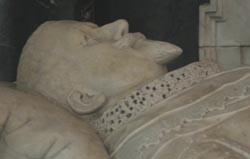
Piet Hein
In 1628, Pieterszoon Hein sailed out to capture the Spanish fleet loaded with silver from their American colonies. Part of this fleet had been warned that Hein had been spotted, but the other half continued its voyage. Twelve Spanish ships were trapped off the Cuban coast in the Bay of Matanzas, and Hein captured about twelve million guilders of booty in silver and other expensive trade goods. He returned to the Netherlands in 1629, where he was hailed as a national hero. Hein's elegant mausoleum features a marble statue of the naval hero lying on his back. The plinth and statue were sculpted from a single block of marble. This sculpture rests on a pedestal of black marble.
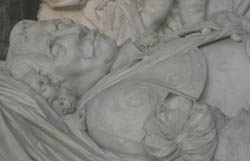
Maarten Tromp
An elaborate and elegant mausoleum was erected at the northern side of the church in remembrance of Maarten Harpertszoon Tromp, the highly decorated Dutch admiral who heroically died in battle. In 1639, during the Dutch struggle for independence from Spain, Tromp defeated a large Spanish fleet bound for Flanders at the Battle of the Downs, marking the end of Spanish naval power. In a preliminary battle, the Action of 18 September, 1639. Tromp was the first fleet commander known to deliberately use line of battle tactics. His flagship in this period was the Aemilia. The death of Tromp was not only a severe blow to the Dutch navy, but also to the Orangists who sought the defeat of the Commonwealth of England and restoration of the Stuart monarchy.
Anthony van Leeuwenhoek
The memorial and rave of the Delft physicist and inventor of the microscope Anthony van Leeuwenhoek is in the tower wall, on the side of the northern aisle.
Churches and religion in Delft
The Nieuwe Kerk and the Oude Kerk were originally built as Catholic churches. The former was dedicated to the Virgin Mary and Saint Ursula, while the latter was dedicated to Saint Bartholomew and Saint Hippolytus. All this was changed by the Reformation, the sixteenth-century reform movement in Christianity. Calvinism, named after the Swiss reformer John Calvin, became the most important Protestant denomination in the Northern Netherlands. Calvin's followers did not accept the teachings of the Catholic church as the guideline for their lives, but lived by the words of the Bible. The resulting religious strife was a major factor in the Eighty Years War.
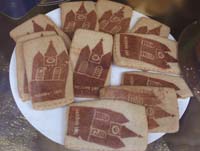
At the conclusion of this War the Reformed Church became the national church of the Dutch Republic. AlI churches, including the SS. Bartholomew & Hippolytus [Oude Kerk] and the SS. Mary & Ursula [Nieuwe Kerk], became the property of the Reformed Church. Catholics did enjoy religious liberties, but were not allowed to express their faith in public, which is why they built clandestine churches.
Whole families were split by the Reformation. Part of the prominent patrician Van der Dussen family, far example, remained true to the teachings of the Catholic Church, while the majority, those who aimed far public office, converted to the Reformed Church.
from:
"The Most beautiful and Loveliest Town of Holland: A Visit to Delft in the Seventeenth Century, " in The Public and the Private in the Age of Vermeer, Osaka, 2000, pp. 26–27
The Nieuwe Kerk (New Church), the second parish church of Delft, was built between 1383 and 1510. The massive tower built between 1396 and 1496. The present spire dates from 1875. The memorial monument (1614–1622) of Prince William of Orange. At present it is a Dutch Reformed Church.
The church tower appears illuminated by the morning sun in Vermeer's own masterful landscape, View of Delft. It has been noticed that in Vermeer's painting the bells are not visible. According to the independent Dutch art historian Kees Kaldenbach, "the delivery by the Hemony firm of the carillon of the New Church tower started in 1660 by hoisting down existing bells of the New Church tower to a shed at ground level. All bells were hoisted up again late in the summer of 1661. This supports the dating in 1660–1661, a period being previously suggested on the basis of Vermeer's stylistic development."
One chronicle tells us that the 36 bells installed in the Nieuwe Kerk were "the latest thing." Their music must have been a permanent enrichment in Vermeer's life, who would have heard them every day from his studio n earby.
Vermeer was christened in this church October 31, 1632.
http://archimon.tripod.com/zuid-holland/delftnieuwekerk.html
Vermeer's father, Reynier Jansz. Vos (he adopted Vos as his name in the mid-1620s), rented a house at Voldersgracht in which he started an inn in order to make a better living for his family. The inn was named the "Flying Fox," in Dutch, "de Vliegende Vos." The inn's name may not have been coincidental. Reynier ran a combination of an inn and a trade in fine art paintings. Vermeer lived in the Flying Fox, with his parents at least in 1635 and perhaps until as late as 1641.
According to the municipal information panel outside on Voldersgracht canal, Vermeer was born on the premises of Voldersgracht 26. However, independent Dutch art historian, Kees Kaldenbach, in recent research has conjectured that Vermeer was born at Voldersgracht number 25 and not at number 26.
Vermeer must have grown up among paintings and artists who no doubt came to eat drink and talk shop there with his father. In 1641, when Vermeer's was about nine years old, his father's business undertakings must have grown considerably since he left Flying Fox for the much larger inn called "Mechelen."
For more information of the arguments, see Kaldenbach's excellent website at:
http://www.xs4all.nl/~kalden/dart/d-a-vermeer2.htm
Vermeer's father, Reynier Jansz. was born in 26 Beestenmarkt (right k.) in 1615. It was then called the "Nassau House." Vermeer's relations on his father's side lived in the Beestenmarkt where many artisans were established.
Fabritius' curious picture shows a stall of a dealer in musical instruments in the center of Delft. It has been hypothesized that the artists may have employed the camera obscura or some sort of optical device in this work. Although Fabritius lived only briefly in Delft, where he died tragically in the explosion of the gunpowder magazine ("Delft Thunderclap"), it is believed he left a lasting impression on artists who lived their, including the younger Vermeer. Fabritius was considered Rembrandt's most talented pupil.
The function and original display of the painting have been much debated. The picture may have formed part of a perspective box or peepshow. This would account for its exaggerated perspective, and the cutting-off of the foreshortened viola da gamba in the foreground. Such a perspective box probably had a curved back onto which the canvas was mounted. Fabritius was interested in perspective and illusionism, and is described in four documents as having made perspective boxes.
"This small painting is the only known visual evidence of the artist's famous expertise in the use of linear perspective. It depicts the center of Delft, with the Nieuwe Kerk seen from the southeast, facing the town hall in the distance (the gray building beyond the bridge in the left background). The Oude Langendijk recedes on the left, the Vrouwenrecht on the right. These streets and their canals (now filled in) meet at an acute angle (see no. 10 on the Delft city map). On the right, a bridge arches steeply aver the Oude Langendijk's canal, which continues straight on to the east (toward the lower right comer o the composition). The houses on the Vrouwenrecht still exist, except for the one on the comer. The church looks much the same, although it gained a taller steeple in 1872"1
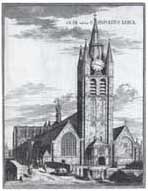
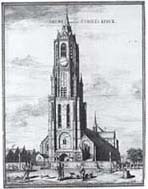
If you discover a  or anything else that isn't working as it should be, I'd love to hear it! Please write me at: jonathanjanson@essentialvermeer.com
or anything else that isn't working as it should be, I'd love to hear it! Please write me at: jonathanjanson@essentialvermeer.com